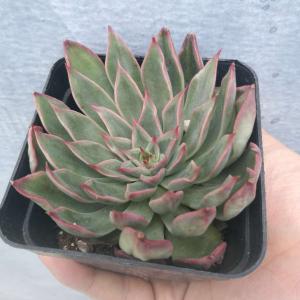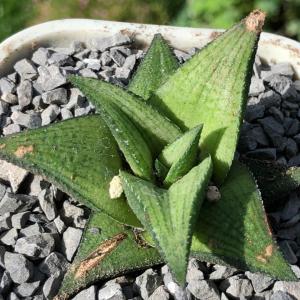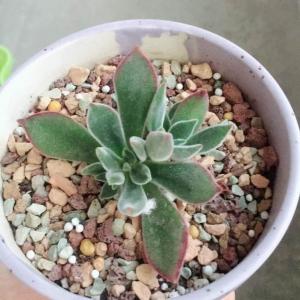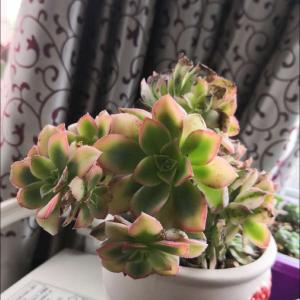文章
Miss Chen
2018年05月23日

Description: This perennial wildflower is ¾-3' tall and usually unbranched, except near the apex where the inflorescence occurs. Erect leafy stems may be produced individually or in small clusters. The central stem is is whitish green, 4-angled, and covered with either glandular or non-glandular hairs (or both). Pairs of opposite leaves occur along each stem. The leaf blades are 1-4" long and ¾-3" across; they are cordate in shape with coarse dentate-crenate margins. The upper blade surface is medium to dark green and either sparsely covered with short hairs or glabrous. The lower surface is slightly more pale and varies from densely hairy to sparsely hairy (rarely glabrous). The slender petioles are ½-2" long and hairy.
The central stem terminates in a raceme of flowers about 3-12" long. In addition, any upper lateral stems may produce smaller racemes of flowers. The racemes are narrow and usually only a few flowers are in bloom at the same time. Individual flowers are ½-1" long. Each flower consists of a blue-violet or purple corolla with 2 lips, a short tubular calyx with 2 lips, 4 inserted stamens, and a pistil with an inserted style. The corolla is much longer than the calyx. The corolla is narrow and tubular at its base, but becomes more wide and swollen towards its lips. The upper lip of the corolla consists of a protective hood, while the lower lip is larger, more rounded, and somewhat lobed. There is usually a large patch of white along the inside of the lower lip that is speckled blue-violet or purple. The calyx is about 1/8" (3 mm.) long, whitish green, and covered with glandular hairs. A protuberance occurs along the upper side of each calyx. The pedicels of theDistribution Map flowers are very short (about 1/8" or 3 mm. in length). Underneath the flowers, there are leafy bracts of variable length: on some plants, they extend as far as the tips of the calyces, but no further, while on other plants they extend beyond the tips of the calyces. These bracts are ovate in shape. The blooming period typically occurs from late spring to mid-summer, lasting about 1 month. However, if a stem is damaged, this may delay flowering until later in the year. Afterward, the flowers are replaced by small dark nutlets. The root system is fibrous and either rhizomatous or stoloniferous.
Cultivation: The preference is dappled sunlight to medium shade, mesic conditions, and soil that contains loam, some calcareous sand, or rocky material (typically limestone). This wildflower is a good choice for shade gardens.
Range & Habitat: The native Heart-Leaved Skullcap is occasional throughout Illinois. Habitats include upland woodlands that are often rocky, bottomland woodlands, bluffs, woodland openings, shaded areas along cliffs, edges of limestone glades, and thickets. This wildflower is usually found in higher quality woodlands where the original ground flora is still intact.
Faunal Associations: The flowers are cross-pollinated by long-tongued bees, particularly bumblebees and Anthophorine bees (Anthophora spp.), which suck nectar and collect pollen. Short-tongued bees and Syrphid flies may also visit the flowers, but they are too small to be effective pollinators. Swallowtail butterflies and other butterflies occasionally visit the flowers, but they are also less effective at cross-pollination according to Robertson (1929). A few species of insects feed on the leaves of Heart-Leaved Skullcap and other skullcaps (Scutellaria spp.). These species include the skeletonizing leaf beetle Phyllobrotica limbata, Asphaera lustrans (Shiny Flea Beetle), larvae of Prochoreutis inflatella (Skullcap Skeletonizer Moth), and larvae of the moth Caloptilia scutellariella. The larvae of this last species are both blotch leaf-miners and leaf-folders. Because of its bitter taste and possible toxicity, mammalian herbivores rarely feed on the foliage.
Photographic Location: A floodplain woodland in Lake County, Illinois. The photographed plants are either Scutellaria ovata ovata or Scutellaria ovata bracteata. The photographs (Copyright © 2011) were taken by Paul Showers.

Comments: Unlike many other Scutellaria spp., this skullcap has mostly heart-shaped leaves with indented bases; sometimes the uppermost leaves have bases that are rounded, rather than indented. Across its range, Heart-Leaved Skullcap is highly variable and several subspecies have been recognized. In Illinois, three of these subspecies can be found: Scutellaria ovata ovata, Scutellaria ovata bracteata, and Scutellaria ovata rugosa. The first two subspecies occur throughout Illinois and they are distinguished by the size of the leafy bracts on their racemes: Scutellaria ovata ovata has leafy bracts that extend no farther than the calyces of the flowers, while Scutellaria ovata bracteata has leafy bracts that extend beyond the calyces of the flowers. The third subspecies, Scutellaria ovata rugosa, is only found in southern Illinois. It can be distinguished from the preceding subspecies by its small size (less than 1' tall) and small leaves (less than 1½" long).
The central stem terminates in a raceme of flowers about 3-12" long. In addition, any upper lateral stems may produce smaller racemes of flowers. The racemes are narrow and usually only a few flowers are in bloom at the same time. Individual flowers are ½-1" long. Each flower consists of a blue-violet or purple corolla with 2 lips, a short tubular calyx with 2 lips, 4 inserted stamens, and a pistil with an inserted style. The corolla is much longer than the calyx. The corolla is narrow and tubular at its base, but becomes more wide and swollen towards its lips. The upper lip of the corolla consists of a protective hood, while the lower lip is larger, more rounded, and somewhat lobed. There is usually a large patch of white along the inside of the lower lip that is speckled blue-violet or purple. The calyx is about 1/8" (3 mm.) long, whitish green, and covered with glandular hairs. A protuberance occurs along the upper side of each calyx. The pedicels of theDistribution Map flowers are very short (about 1/8" or 3 mm. in length). Underneath the flowers, there are leafy bracts of variable length: on some plants, they extend as far as the tips of the calyces, but no further, while on other plants they extend beyond the tips of the calyces. These bracts are ovate in shape. The blooming period typically occurs from late spring to mid-summer, lasting about 1 month. However, if a stem is damaged, this may delay flowering until later in the year. Afterward, the flowers are replaced by small dark nutlets. The root system is fibrous and either rhizomatous or stoloniferous.
Cultivation: The preference is dappled sunlight to medium shade, mesic conditions, and soil that contains loam, some calcareous sand, or rocky material (typically limestone). This wildflower is a good choice for shade gardens.
Range & Habitat: The native Heart-Leaved Skullcap is occasional throughout Illinois. Habitats include upland woodlands that are often rocky, bottomland woodlands, bluffs, woodland openings, shaded areas along cliffs, edges of limestone glades, and thickets. This wildflower is usually found in higher quality woodlands where the original ground flora is still intact.
Faunal Associations: The flowers are cross-pollinated by long-tongued bees, particularly bumblebees and Anthophorine bees (Anthophora spp.), which suck nectar and collect pollen. Short-tongued bees and Syrphid flies may also visit the flowers, but they are too small to be effective pollinators. Swallowtail butterflies and other butterflies occasionally visit the flowers, but they are also less effective at cross-pollination according to Robertson (1929). A few species of insects feed on the leaves of Heart-Leaved Skullcap and other skullcaps (Scutellaria spp.). These species include the skeletonizing leaf beetle Phyllobrotica limbata, Asphaera lustrans (Shiny Flea Beetle), larvae of Prochoreutis inflatella (Skullcap Skeletonizer Moth), and larvae of the moth Caloptilia scutellariella. The larvae of this last species are both blotch leaf-miners and leaf-folders. Because of its bitter taste and possible toxicity, mammalian herbivores rarely feed on the foliage.
Photographic Location: A floodplain woodland in Lake County, Illinois. The photographed plants are either Scutellaria ovata ovata or Scutellaria ovata bracteata. The photographs (Copyright © 2011) were taken by Paul Showers.

Comments: Unlike many other Scutellaria spp., this skullcap has mostly heart-shaped leaves with indented bases; sometimes the uppermost leaves have bases that are rounded, rather than indented. Across its range, Heart-Leaved Skullcap is highly variable and several subspecies have been recognized. In Illinois, three of these subspecies can be found: Scutellaria ovata ovata, Scutellaria ovata bracteata, and Scutellaria ovata rugosa. The first two subspecies occur throughout Illinois and they are distinguished by the size of the leafy bracts on their racemes: Scutellaria ovata ovata has leafy bracts that extend no farther than the calyces of the flowers, while Scutellaria ovata bracteata has leafy bracts that extend beyond the calyces of the flowers. The third subspecies, Scutellaria ovata rugosa, is only found in southern Illinois. It can be distinguished from the preceding subspecies by its small size (less than 1' tall) and small leaves (less than 1½" long).
0
0
文章
Miss Chen
2018年05月22日

Description: This herbaceous perennial plant is about 3½-8' tall, branching occasionally. The stems are often 4-angled and furrowed; they are slightly hairy or glabrous. The opposite leaves are up to 7" long and 3½" across (excluding the petioles), becoming somewhat smaller as they ascend the stems. These leaves are medium to dark green, cordate-ovate to ovate in shape, serrated along their margins, thin-textured, and largely hairless, except for some short pubescence along the undersides of their veins. The slender petioles are up to 2½" long; they are light green to red and glabrous to slightly hairy. The upper stems terminate in elongated panicles of flowers up to 1' long. Each panicle is somewhat cylindrical in shape, consisting of an erect central stalk (rachis) with short lateral branches that are widely spreading to ascending. Both the central stalk and lateral branches are light green; the latter also have short glandular pubescence, and they are slender and wiry. There are individual bracts (green, linear in shape, and up to 1" in length) that become progressively smaller as the panicle branches.
Individual flowers are about 8 mm. (1/3") long and short-cylindrical in shape; each flower has a short-tubular green calyx with 5 blunt teeth and a corolla with 5 rounded lobes. The exterior of the corolla is dull green, while its interior is predominantly reddish brown. Each corolla has a pair of upper lobes that function as a hood, 2 short lateral lobes, and a lower lobe that curves downward. All of these lobes are reddish brown on the inside, except the lower lobe, which is greenish yellow. Appressed against the upper interior of this corolla, there is an infertile stamen that is reddish brown or purple. The 4 fertile stamens have yellow anthers; they are located toward the bottom of the corolla. The slender pedicels are a little longer than the flowers. The blooming period occurs from mid-summer to early fall, lasting about a month; only a few flowers are in bloom at the same time. Each flower is replaced by a 2-celled capsule that contains numerous tiny seeds. The root system is rhizomatous and knotty-tuberous.

Cultivation: The preference is medium shade to partial sun, moist to mesic conditions, and soil that is loose and loamy. The size of this plant can be highly variable, depending on its age, location, and environmental conditions.
Range & Habitat: Late Figwort (Scrophularia marilandica) is a fairly common plant that has been observed in most counties of Illinois (see Distribution Map), where it is native. Habitats include mesic deciduous woodlands, sandy woodlands, savannas, edges of shaded hillside seeps, woodland borders, thickets, and fence rows that are overgrown with trees. This species tolerates minor to moderate levels of disturbance.

Faunal Associations: The small flowers contain abundant nectar, which attracts the Ruby-throated Hummingbird, honeybees, bumblebees, leaf-cutting bees (Megachile spp.), a long-horned bee (Melissodes bimaculata), Halictid bees (Halictus spp., Lasioglossum spp., etc.), Vespid wasps (Polites spp., Vespula spp.), and various Eumenine wasps (Robertson, 1929). Halictid bees also collect pollen from the flowers. Insects that feed destructively on the leaves, plant juices, and other parts of Late Figwort and other figworts (Scrophularia spp.) include larvae of the gall fly Lestodiplosis scrophulariae, the stink bug Cosmopepla lintneriana, the aphid Myzus scrophulariae, the flea beetle Capraita thyamoides, and caterpillars of the moth Elaphria chalcedonia (Chalcedony Midget). Because the foliage is bitter and acrid, it is rarely browsed by mammalian herbivores.

Photographic Location: Busey Woods in Urbana, Illinois. A small colony of Late Figwort (Scrophularia marilandica) was growing in a mesic area of this deciduous woodlands.
Comments: The figworts (Scrophularia spp.) have weird little flowers that attract many wasps and bees. They are not grown in gardens very often because their flowers are not very showy (by human standards). The only other figwort that occurs in Illinois is Early Figwort (Scrophularia lanceolata). This species is less common than Late Figwort (Scrophularia marilandica); in Illinois, it is found only in the northern section of the state. Early Figwort blooms a little earlier than Late Figwort (hence their common names), although their respective blooming periods overlap to some extent. The flowers of Early Figwort have sterile stamens that are yellow, rather than reddish brown or purple (the sterile stamens of both species are located along the upper interior of their corollas).
Individual flowers are about 8 mm. (1/3") long and short-cylindrical in shape; each flower has a short-tubular green calyx with 5 blunt teeth and a corolla with 5 rounded lobes. The exterior of the corolla is dull green, while its interior is predominantly reddish brown. Each corolla has a pair of upper lobes that function as a hood, 2 short lateral lobes, and a lower lobe that curves downward. All of these lobes are reddish brown on the inside, except the lower lobe, which is greenish yellow. Appressed against the upper interior of this corolla, there is an infertile stamen that is reddish brown or purple. The 4 fertile stamens have yellow anthers; they are located toward the bottom of the corolla. The slender pedicels are a little longer than the flowers. The blooming period occurs from mid-summer to early fall, lasting about a month; only a few flowers are in bloom at the same time. Each flower is replaced by a 2-celled capsule that contains numerous tiny seeds. The root system is rhizomatous and knotty-tuberous.

Cultivation: The preference is medium shade to partial sun, moist to mesic conditions, and soil that is loose and loamy. The size of this plant can be highly variable, depending on its age, location, and environmental conditions.
Range & Habitat: Late Figwort (Scrophularia marilandica) is a fairly common plant that has been observed in most counties of Illinois (see Distribution Map), where it is native. Habitats include mesic deciduous woodlands, sandy woodlands, savannas, edges of shaded hillside seeps, woodland borders, thickets, and fence rows that are overgrown with trees. This species tolerates minor to moderate levels of disturbance.

Faunal Associations: The small flowers contain abundant nectar, which attracts the Ruby-throated Hummingbird, honeybees, bumblebees, leaf-cutting bees (Megachile spp.), a long-horned bee (Melissodes bimaculata), Halictid bees (Halictus spp., Lasioglossum spp., etc.), Vespid wasps (Polites spp., Vespula spp.), and various Eumenine wasps (Robertson, 1929). Halictid bees also collect pollen from the flowers. Insects that feed destructively on the leaves, plant juices, and other parts of Late Figwort and other figworts (Scrophularia spp.) include larvae of the gall fly Lestodiplosis scrophulariae, the stink bug Cosmopepla lintneriana, the aphid Myzus scrophulariae, the flea beetle Capraita thyamoides, and caterpillars of the moth Elaphria chalcedonia (Chalcedony Midget). Because the foliage is bitter and acrid, it is rarely browsed by mammalian herbivores.

Photographic Location: Busey Woods in Urbana, Illinois. A small colony of Late Figwort (Scrophularia marilandica) was growing in a mesic area of this deciduous woodlands.
Comments: The figworts (Scrophularia spp.) have weird little flowers that attract many wasps and bees. They are not grown in gardens very often because their flowers are not very showy (by human standards). The only other figwort that occurs in Illinois is Early Figwort (Scrophularia lanceolata). This species is less common than Late Figwort (Scrophularia marilandica); in Illinois, it is found only in the northern section of the state. Early Figwort blooms a little earlier than Late Figwort (hence their common names), although their respective blooming periods overlap to some extent. The flowers of Early Figwort have sterile stamens that are yellow, rather than reddish brown or purple (the sterile stamens of both species are located along the upper interior of their corollas).
0
0
文章
Miss Chen
2018年05月22日

Description: This wildflower consists of a rosette of basal leaves and a flowering stalk about 1-3' tall. Individual basal leaves are up to 9" long and 3" across; they are oblong to ovate-oblong, crenate or smooth along their margins, and medium green. Basal leaves are glabrous to sparsely hairy on their upper surfaces, while their lower surfaces are sparsely to moderately hairy. Generally, young leaves are more hairy than older leaves. The inflorescence consists of a panicle of flowers, which develops from an erect central stalk. This stalk is fairly stout, terete, and densely covered with spreading hairs. The panicle is ellipsoid in shape, ½–1½' long, and about 1/3 as much across when it is fully extended. The branches of the panicle are ascending to spreading and usually pubescent. There is a single linear-lanceolate bract at each major fork of the branches. Depending on the size of the inflorescence, the flowers vary in abundance; they usually bloom at about the same time. Each flower is ¼" across, consisting of 5 narrow white petals, 5 green sepals that are joined together at the base, 10 stamens with white to orange-brown anthers, and 2 prominent pistils that are green and joined together. The sepals are triangular in shape and become recurved when the flowers bloom. The petals are longer than the sepals. The blooming period occurs during the late spring for 2-3 weeks. Each flower is replaced by a pair of beaked follicles; each follicle splits open along one side to release its seeds. The root system consists of a crown of fleshy fibrous roots and rhizomes. Clonal offsets from the rhizomes are often formed.
Cultivation: The preference is light shade to partial sun, consistently moist conditions, high humidity, and thin rocky soil containing sandstone. The site should be protected from prevailing winds.
Range & Habitat: The native Forbe's Saxifrage is found in southern Illinois (where it is uncommon) and 3 counties in northern Illinois, where it is rare; it is absent from the remaining areas of the state (see Distribution Map). This map excludes the distribution of the more common typical variety, Saxifraga pensylvanica pensylvanica (Swamp Saxifrage). Habitats are largely restricted to the lower slopes of rocky bluffs (usually north-facing), moist ledges along sandstone ravines, and the lower slopes of sandstone canyons, particularly where some seepage of moisture occurs. These habitats are always found in wooded areas with varying amounts of shade. Forbe's Saxifrage is restricted to high quality natural areas.
Faunal Associations: The flowers are cross-pollinated primarily by small bees, wasps, and various flies. Less common visitors include sawflies and beetles. These insects usually suck nectar, although some of the bees also collect pollen, while some flies and beetles prefer to feed on the pollen. These observations are from Graenicher.
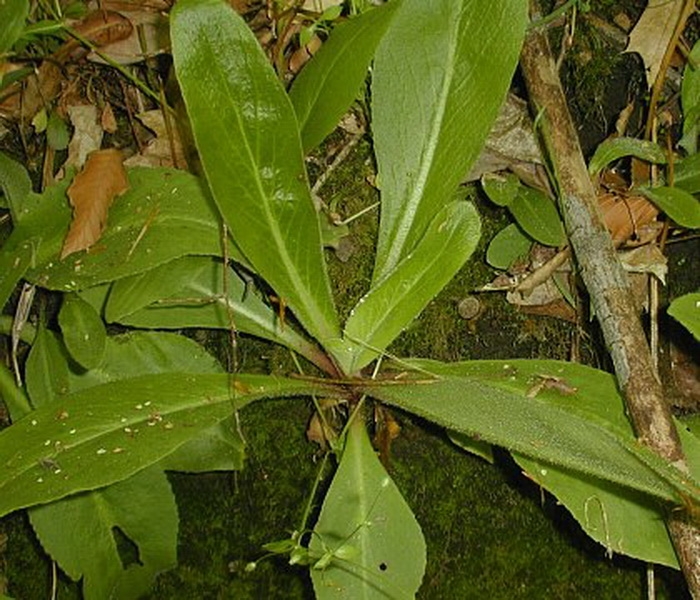
Photographic Location: Lower slope of a sandstone canyon at the Portland Arch in west-central Indiana.
Comments: I have selected Vasey's taxonomic classification of Forbe's Saxifrage. This is something of a compromise. Some botanists in Illinois and Indiana (e.g., Mohlenbrock, 2002) classify Forbe's Saxifrage as a separate species, Saxifraga forbesii, rather than a variety of Saxifraga pensylvanica (Swamp Saxifrage). Other botanists don't recognize Forbe's Saxifrage at even the varietal level. Generally, Forbe's Saxifrage is supposed to have hairier basal leaves than Swamp Saxifrage, and the petals of its flowers are longer than the sepals. Swamp Saxifrage is supposed to have slightly smaller flowers, where the petals are about the same length as the sepals. Swamp Saxifrage is found primarily in the northern half of Illinois, where it is found in both sunny and shaded wetlands. The only other Saxifrage in Illinois is Saxifraga virginiensis (Early Saxifrage), which has been found only in Hardin County. This latter species is much smaller in size; it prefers drier upland areas and can bloom as early as mid-spring.
Cultivation: The preference is light shade to partial sun, consistently moist conditions, high humidity, and thin rocky soil containing sandstone. The site should be protected from prevailing winds.
Range & Habitat: The native Forbe's Saxifrage is found in southern Illinois (where it is uncommon) and 3 counties in northern Illinois, where it is rare; it is absent from the remaining areas of the state (see Distribution Map). This map excludes the distribution of the more common typical variety, Saxifraga pensylvanica pensylvanica (Swamp Saxifrage). Habitats are largely restricted to the lower slopes of rocky bluffs (usually north-facing), moist ledges along sandstone ravines, and the lower slopes of sandstone canyons, particularly where some seepage of moisture occurs. These habitats are always found in wooded areas with varying amounts of shade. Forbe's Saxifrage is restricted to high quality natural areas.
Faunal Associations: The flowers are cross-pollinated primarily by small bees, wasps, and various flies. Less common visitors include sawflies and beetles. These insects usually suck nectar, although some of the bees also collect pollen, while some flies and beetles prefer to feed on the pollen. These observations are from Graenicher.

Photographic Location: Lower slope of a sandstone canyon at the Portland Arch in west-central Indiana.
Comments: I have selected Vasey's taxonomic classification of Forbe's Saxifrage. This is something of a compromise. Some botanists in Illinois and Indiana (e.g., Mohlenbrock, 2002) classify Forbe's Saxifrage as a separate species, Saxifraga forbesii, rather than a variety of Saxifraga pensylvanica (Swamp Saxifrage). Other botanists don't recognize Forbe's Saxifrage at even the varietal level. Generally, Forbe's Saxifrage is supposed to have hairier basal leaves than Swamp Saxifrage, and the petals of its flowers are longer than the sepals. Swamp Saxifrage is supposed to have slightly smaller flowers, where the petals are about the same length as the sepals. Swamp Saxifrage is found primarily in the northern half of Illinois, where it is found in both sunny and shaded wetlands. The only other Saxifrage in Illinois is Saxifraga virginiensis (Early Saxifrage), which has been found only in Hardin County. This latter species is much smaller in size; it prefers drier upland areas and can bloom as early as mid-spring.
0
0
文章
Miss Chen
2018年05月21日

Description: This herbaceous perennial plant is about 1½–3' tall. It is more or less erect and either sparingly branched or unbranched. The stems are light green to dark purple, angular-terete, and slightly pubescent. Pairs of opposite leaves occur along each stem. The leaf blades are up to 5" long and 2½" across; they are dull green, hairless, ovate in shape, and crenate-dentate along their margins. The lower leaves have slender petioles up to one-half the length of their blades, while the upper leaves have much shorter petioles.
The upper stems terminate in slender spike-like racemes of flowers up to 1' long. In addition, secondary racemes are often produced from the uppermost pairs of leaves. The flowers are arranged in opposite pairs along the upper one-half or upper one-third of each raceme. The central stalk of the raceme is usually dark purple. Each flower is up to 1/3" (8 mm.) in length; it consists of a tubular-ovoid calyx and a slender corolla that is pale purplish white and divides into two lips. The small upper lip has a rounded edge, which is slightly indented in the middle; the long lower lip divides into 3 lobes, functioning as a landing pad for visiting insects. Within the corolla, there is a single style and 4 stamens. The small calyx is light green and hairless; it has 3 teeth that are long, slender, and purple along its upper/outer side, while the opposite side of the calyx has a pair of much smaller teeth. The pedicels of the flowers are very short; at the base of each pedicel, there is a pair of tiny bracts (bracteoles). While individual flowers are blooming, they are held horizontally; shortly afterwards, their corollas fall away and their calyces bend downward to become appressed against the stalk of their racemes. The blooming period occurs during the summer and lasts 1-2 months. Only a few flowers are in bloom at the same time. Each flower produces a single seed that develops within the calyx. This plant reproduces by reseeding itself.
Cultivation: Lopseed prefers a sheltered location that provides light to medium shade, moist to mesic conditions, and a rich woodland soil with abundant organic matter.

Range & Habitat: The native Lopseed has been found in most counties of Illinois, however it is only occasionally encountered and its populations are scattered (Distribution Map). Habitats include rich deciduous woodlands in moist to mesic conditions. Lopseed is largely restricted to higher quality woodlands where the original ground flora is still intact. While it is little known, Lopseed has a wide distribution in North America and east-central Asia.
Faunal Associations: Small bees occasionally visit the flowers for nectar. Robertson (1928) observed only two bees, Ceratina dupla and Augochlorella striata, as floral visitors of Lopseed. The former species is a Little Carpenter bee, while the latter species is a Green Metallic bee. Other records of floral-faunal relationships are sparse. A polyphagous insect, Proxys punctulatus (Black Stink Bug), sucks juices from the foliage of Lopseed (and many other plants). White-Tailed Deer reportedly dislike this plant as a food source and don't graze on the foliage.
Photographic Location: Spitzler Woods in Macon County, Illinois. The photographs were taken during the autumn when the flowers were no longer in bloom.

Comments: This woodland plant is often overlooked because it lacks showy flowers. As a general rule, shade-loving woodland plants that bloom during the summer have small light-colored flowers because they have access to very limited amounts of energy from low levels of sunlight. Plants that grow in open woodlands or prairies have access to more sunlight and usually produce larger flowers. Woodland wildflowers that bloom in the spring can also produce large showy flowers, largely because the canopy trees haven't fully developed their leaves, and thus more sunlight reaches the ground vegetation. Lopseed is an unusual plant that has been assigned to its own plant family. It resembles members of the Mint family (Lamiaceae) in many ways, but each of its flowers produces only a single seed. In contrast, individual flowers of plants in the Mint family typically produce either 2 or 4 seeds.
The upper stems terminate in slender spike-like racemes of flowers up to 1' long. In addition, secondary racemes are often produced from the uppermost pairs of leaves. The flowers are arranged in opposite pairs along the upper one-half or upper one-third of each raceme. The central stalk of the raceme is usually dark purple. Each flower is up to 1/3" (8 mm.) in length; it consists of a tubular-ovoid calyx and a slender corolla that is pale purplish white and divides into two lips. The small upper lip has a rounded edge, which is slightly indented in the middle; the long lower lip divides into 3 lobes, functioning as a landing pad for visiting insects. Within the corolla, there is a single style and 4 stamens. The small calyx is light green and hairless; it has 3 teeth that are long, slender, and purple along its upper/outer side, while the opposite side of the calyx has a pair of much smaller teeth. The pedicels of the flowers are very short; at the base of each pedicel, there is a pair of tiny bracts (bracteoles). While individual flowers are blooming, they are held horizontally; shortly afterwards, their corollas fall away and their calyces bend downward to become appressed against the stalk of their racemes. The blooming period occurs during the summer and lasts 1-2 months. Only a few flowers are in bloom at the same time. Each flower produces a single seed that develops within the calyx. This plant reproduces by reseeding itself.
Cultivation: Lopseed prefers a sheltered location that provides light to medium shade, moist to mesic conditions, and a rich woodland soil with abundant organic matter.

Range & Habitat: The native Lopseed has been found in most counties of Illinois, however it is only occasionally encountered and its populations are scattered (Distribution Map). Habitats include rich deciduous woodlands in moist to mesic conditions. Lopseed is largely restricted to higher quality woodlands where the original ground flora is still intact. While it is little known, Lopseed has a wide distribution in North America and east-central Asia.
Faunal Associations: Small bees occasionally visit the flowers for nectar. Robertson (1928) observed only two bees, Ceratina dupla and Augochlorella striata, as floral visitors of Lopseed. The former species is a Little Carpenter bee, while the latter species is a Green Metallic bee. Other records of floral-faunal relationships are sparse. A polyphagous insect, Proxys punctulatus (Black Stink Bug), sucks juices from the foliage of Lopseed (and many other plants). White-Tailed Deer reportedly dislike this plant as a food source and don't graze on the foliage.
Photographic Location: Spitzler Woods in Macon County, Illinois. The photographs were taken during the autumn when the flowers were no longer in bloom.

Comments: This woodland plant is often overlooked because it lacks showy flowers. As a general rule, shade-loving woodland plants that bloom during the summer have small light-colored flowers because they have access to very limited amounts of energy from low levels of sunlight. Plants that grow in open woodlands or prairies have access to more sunlight and usually produce larger flowers. Woodland wildflowers that bloom in the spring can also produce large showy flowers, largely because the canopy trees haven't fully developed their leaves, and thus more sunlight reaches the ground vegetation. Lopseed is an unusual plant that has been assigned to its own plant family. It resembles members of the Mint family (Lamiaceae) in many ways, but each of its flowers produces only a single seed. In contrast, individual flowers of plants in the Mint family typically produce either 2 or 4 seeds.
0
0
文章
Miss Chen
2018年05月20日

Description: This biennial plant is 1-2' tall, branching occasionally. The stems are light green, terete, and covered with spreading hairs; these hairs are often glandular. The alternate leaves are simple-pinnate; they are usually divided into 3-5 leaflets (rarely 7). The leaf blades are up to 5" long and 3" across; the petioles of these leaves become shorter as they ascend the stems. The leaflets of each blade are ovate, broadly ovate, oblong, or oblanceolate in shape; they are shallowly to deeply cleft and bluntly dentate along their margins. Often, the terminal leaflets are more deeply cleft than the lateral leaflets. Both leaf blades and petioles are more or less hairy. The upper surfaces of mature blades are medium to dark green; however, theClose-up of Flower earliest leaf-blades of the year have upper surfaces with silver-grey blotches. The upper stems terminate in racemes of 4-12 flowers; often there are a few secondary racemes that develop from the axils of the upper leaves. Buds and flowers are typically concentrated toward the apex of each raceme, while the developing fruits are located below on spreading pedicels. These pedicels are glandular-hairy and about ½" long. Each flower is about ½" across when it is in bloom; it consists of a 5-lobed corolla, a calyx with 5 sepals, 5 stamens, a slender style, and an ovary. The corolla can vary in color from pale lavender to deep blue-violet. The green sepals are linear-lanceolate and hairy; they become recurved during and after the blooming period. The style of each flower divides into 2 parts toward the middle of its length, while the stamens have finely hairy filaments and brownish anthers. The blooming period occurs during the late spring and lasts about a month. Each flower is replaced by an ovoid seed capsule that divides into 2 parts to release its seeds. This plant reproduces by reseeding itself.
Cultivation: The preference is dappled sunlight to light shade, moist conditions, and a rather rich loam or silt-loam containing organic matter. After the flowering period, more shade from canopy trees is tolerated because this plant dies down. While this plant doesn't grow on rocks like some ferns, it tolerates soil that is somewhat thin and rocky from underlying bedrock if there is enough moisture.
Range & Habitat: The native Forest Phacelia occurs occasionally in the southern half of Illinois, while in the northern half of the state it is rare or absent (see Distribution Map). Habitats include moist areas of deciduous woodlands and rocky woodlands, rocky banks and low areas along woodland streams, moist depressions of bluffs, bottoms of sandstone canyons, and lower slopes of ravines. This wildflower is typically found in various moist areas of rocky woodlands.
Faunal Associations: The nectar and pollen of the flowers attract primarily bees (long-tongued & short-tongued); less common floral visitors include butterflies, skippers, and wasps. The foliage of Phacelia spp. (Phacelias) is eaten by the the oligophagous Scelolyperus wilcoxi (Skeletonizing Leaf Beetle sp.). Information about the edibility of the foliage to mammalian herbivores is unavailable.

Photographic Location: The bottom of a sandstone canyon along a woodland stream at the Portland Arch in west-central Indiana.
Comments: Forest Phacelia is another lovely woodland wildflower in the Waterleaf family. This species and other Phacelia spp. (Phacelias) are closely related to the Hydrophyllum spp. (Waterleaf species), which also occur in woodlands and bloom at about the same time. Among the species in Illinois, the style of a Phacelia is divided toward the middle of its length, while the style of a Waterleaf is divided toward its apex; this is the easiest way to distinguish these two groups of very similar wildflowers. Compared to other Phacelias in Illinois, Forest Phacelia usually has larger flowers (about ½" across, if not more) and the lobes of its corollas are smooth, rather than conspicuously fringed. Some species of Waterleaf are similar to it, but they lack tripartite leaves or the lobes of their corollas are less widely spreading when the flowers are blooming. If all else fails, they can be distinguished by their styles, as described above. Another common of Phacelia bipinnatifida is Loose-Flowered Phacelia.
Cultivation: The preference is dappled sunlight to light shade, moist conditions, and a rather rich loam or silt-loam containing organic matter. After the flowering period, more shade from canopy trees is tolerated because this plant dies down. While this plant doesn't grow on rocks like some ferns, it tolerates soil that is somewhat thin and rocky from underlying bedrock if there is enough moisture.
Range & Habitat: The native Forest Phacelia occurs occasionally in the southern half of Illinois, while in the northern half of the state it is rare or absent (see Distribution Map). Habitats include moist areas of deciduous woodlands and rocky woodlands, rocky banks and low areas along woodland streams, moist depressions of bluffs, bottoms of sandstone canyons, and lower slopes of ravines. This wildflower is typically found in various moist areas of rocky woodlands.
Faunal Associations: The nectar and pollen of the flowers attract primarily bees (long-tongued & short-tongued); less common floral visitors include butterflies, skippers, and wasps. The foliage of Phacelia spp. (Phacelias) is eaten by the the oligophagous Scelolyperus wilcoxi (Skeletonizing Leaf Beetle sp.). Information about the edibility of the foliage to mammalian herbivores is unavailable.

Photographic Location: The bottom of a sandstone canyon along a woodland stream at the Portland Arch in west-central Indiana.
Comments: Forest Phacelia is another lovely woodland wildflower in the Waterleaf family. This species and other Phacelia spp. (Phacelias) are closely related to the Hydrophyllum spp. (Waterleaf species), which also occur in woodlands and bloom at about the same time. Among the species in Illinois, the style of a Phacelia is divided toward the middle of its length, while the style of a Waterleaf is divided toward its apex; this is the easiest way to distinguish these two groups of very similar wildflowers. Compared to other Phacelias in Illinois, Forest Phacelia usually has larger flowers (about ½" across, if not more) and the lobes of its corollas are smooth, rather than conspicuously fringed. Some species of Waterleaf are similar to it, but they lack tripartite leaves or the lobes of their corollas are less widely spreading when the flowers are blooming. If all else fails, they can be distinguished by their styles, as described above. Another common of Phacelia bipinnatifida is Loose-Flowered Phacelia.
0
1
文章
Miss Chen
2018年05月20日

Description: This annual plant is about ½–1½' tall and usually unbranched. The central stem is green, 4-angled, and pubescent or hairy. The alternate leaves are up to 3½" long and ¾" across. They are lanceolate, finely pubescent, and smooth or slightly undulate along the margins. Near the base of the upper surface of each leaf, there is a major vein and 2 sides veins that are clearly visible. At the axils of the middle to upper leaves, there are small clusters of bracts and flowers. Each flower is surrounded by several green linear bracts that are hairy or pubescent; these bracts are about 1/6" (4.5 mm.) in length and they are longer than the flowers. The green flowers are staminate (male), pistillate (female), or perfect (male & female). These different kinds of flowers can appear together in the same clusters. All of these flowers have 4 green sepals and no petals. Each staminate flower has 4 stamens, while each female flower has a superior ovary with a style. The perfect flowers have both types of reproductive organs. The blooming period occurs during the summer and lasts about 2-3 months. Cross-pollination of the flowers is by the wind. Each flower with an ovary develops a single ovoid achene. The root system consists of a tuft of fibrous roots. This plant reproduces by reseeding itself and it often forms colonies.
Cultivation: The preference is light shade, moist to slightly dry conditions, and a loamy soil. This species also tolerates partial sun and rocky soil. Generally, it prefers shaded areas where there is little competition from other low-growing plants.
Range & Habitat: The native Pennsylvania Pellitory is a common plant that occurs in most counties of Illinois (see Distribution Map). Habitats include mesic deciduous woodlands, savannas (underneath trees), thickets, limestone glades, areas along cliff bases, fence rows with woody vegetation, shaded areas along buildings and stone walls, barren areas underneath yard trees, and small openings in hedges. This plant occurs in both natural and disturbed areas.
Faunal Associations: Information about floral-fauna relationships for this species is limited. The caterpillars of the butterfly Vanessa atalanta (Red Admiral) feed on the foliage of Pennsylvania Pellitory and other members of the Nettle family. The seeds are eaten by Melospiza lincolnii (Lincoln's Sparrow) during its fall migration through the eastern prairie region (Martin et al., 1951/1961). There is some evidence that deer browse on the foliage, as populations of Pennsylvania Pellitory increased in a savanna after White-Tailed Deer were removed from this habitat (Bradstreet & Bowles, 2003, p. 48).

Photographic Location: Along a stone wall near a back alley in Urbana, Illinois.
Comments: This inconspicuous little plant is easy to overlook. Notwithstanding its lack of showy flowers, this species should be included in more field guides of wildflowers. Pennsylvania Pellitory superficially resembles some Acalypha spp. from the Spurge family, but its leaves lack teeth and its flowers are surrounded by several linear bracts. The flowers of Acalypha spp. are surrounded by a single lobed bract, and their leaves are serrated along the margins. Unlike some other members of the Nettle family, Pennsylvania Pellitory lacks stinging hairs and its foliage is harmless. It is usually a shorter plant than other members of the Nettle family, and its leaves are less broad (¾" across or less).
Cultivation: The preference is light shade, moist to slightly dry conditions, and a loamy soil. This species also tolerates partial sun and rocky soil. Generally, it prefers shaded areas where there is little competition from other low-growing plants.
Range & Habitat: The native Pennsylvania Pellitory is a common plant that occurs in most counties of Illinois (see Distribution Map). Habitats include mesic deciduous woodlands, savannas (underneath trees), thickets, limestone glades, areas along cliff bases, fence rows with woody vegetation, shaded areas along buildings and stone walls, barren areas underneath yard trees, and small openings in hedges. This plant occurs in both natural and disturbed areas.
Faunal Associations: Information about floral-fauna relationships for this species is limited. The caterpillars of the butterfly Vanessa atalanta (Red Admiral) feed on the foliage of Pennsylvania Pellitory and other members of the Nettle family. The seeds are eaten by Melospiza lincolnii (Lincoln's Sparrow) during its fall migration through the eastern prairie region (Martin et al., 1951/1961). There is some evidence that deer browse on the foliage, as populations of Pennsylvania Pellitory increased in a savanna after White-Tailed Deer were removed from this habitat (Bradstreet & Bowles, 2003, p. 48).

Photographic Location: Along a stone wall near a back alley in Urbana, Illinois.
Comments: This inconspicuous little plant is easy to overlook. Notwithstanding its lack of showy flowers, this species should be included in more field guides of wildflowers. Pennsylvania Pellitory superficially resembles some Acalypha spp. from the Spurge family, but its leaves lack teeth and its flowers are surrounded by several linear bracts. The flowers of Acalypha spp. are surrounded by a single lobed bract, and their leaves are serrated along the margins. Unlike some other members of the Nettle family, Pennsylvania Pellitory lacks stinging hairs and its foliage is harmless. It is usually a shorter plant than other members of the Nettle family, and its leaves are less broad (¾" across or less).
0
0
文章
Miss Chen
2018年05月20日

Description: This perennial wildflower is 3-8" tall. It has an unbranched stem that terminates in a whorl of compound leaves and a single flowering stalk. The central stem is light green to dull red and hairless. The compound leaves are palmate with 3-5 leaflets. Individual leaflets are ¾-1½" long and about one-third as much across; they are oblanceolate or elliptic, serrated along their margins, and sessile (or nearly so). The upper surface of the leaves is medium green and hairless. The petioles of the compound leaves are ¾-2" long, light green to dull red, and hairless. The flowering stalk rises 1-3" above the leaves, terminating in a small umbel of white flowers about ¾" across. Like the central stem, it is light green to dull red and hairless. Individual flowers are about 1/8" (3 mm.) across, consisting of 5 white petals, a short white calyx, and 5 white stamens. The flowers of some plants are all staminate (male), while the flowers of other plants are perfect (male & female). Each staminate flower has a single non-functional style, while each perfect flower has 3 styles and a 3-celled ovary. Individual plants are capable of changing their gender from year-to-year. Like the flowers, the pedicels are also white.
The blooming period occurs from mid- to late spring and lasts about 3 weeks. Umbels of perfect flowers are replaced by small clusters of berries. These berries are initially green, but they later become yellow; their texture is rather dry. Each berry contains 2-3 seeds. The white seeds are up to 3 mm. long and 2 mm. across; they are somewhat reniform in shape and their surfaces are reticulated. The root system consists of a globoid tuberous root about ½" across and it occasionally produces rhizomes.
Cultivation: The preference is light shade, moist conditions, and a rich loam with abundant organic material. This wildflower develops quickly during the spring, but dies down during early summer.
Range & Habitat: Dwarf Ginseng is not known to occur in Illinois outside of cultivation (see Distribution Map), although it is native to both Wisconsin and Indiana in areas that are closest to the NE section of the state. Dwarf Ginseng is found in moist rich woodlands where deciduous trees are dominant and the original ground flora is still intact.

Faunal Associations: Very little is known about floral-faunal relationships for this species. The flowers are probably cross-pollinated by small bees and flies.
Photographic Location: A damp area of Goll Woods in NW Ohio.
Comments: It's a pity that Dwarf Ginseng has not been found in Illinois: it is a lovely wildflower. Its closest relative is probably Panax quinquefolius (American Ginseng), which is a larger plant that blooms later in the year. Unlike Dwarf Ginseng, American Ginseng has leaflets with significant petiolules (small basal stalks) and its berries are red, rather than yellow. While it is reportedly edible, the tuberous root of Dwarf Ginseng is not used in herbal medicine. The flavor of this root is supposed to be pungent.
The blooming period occurs from mid- to late spring and lasts about 3 weeks. Umbels of perfect flowers are replaced by small clusters of berries. These berries are initially green, but they later become yellow; their texture is rather dry. Each berry contains 2-3 seeds. The white seeds are up to 3 mm. long and 2 mm. across; they are somewhat reniform in shape and their surfaces are reticulated. The root system consists of a globoid tuberous root about ½" across and it occasionally produces rhizomes.
Cultivation: The preference is light shade, moist conditions, and a rich loam with abundant organic material. This wildflower develops quickly during the spring, but dies down during early summer.
Range & Habitat: Dwarf Ginseng is not known to occur in Illinois outside of cultivation (see Distribution Map), although it is native to both Wisconsin and Indiana in areas that are closest to the NE section of the state. Dwarf Ginseng is found in moist rich woodlands where deciduous trees are dominant and the original ground flora is still intact.

Faunal Associations: Very little is known about floral-faunal relationships for this species. The flowers are probably cross-pollinated by small bees and flies.
Photographic Location: A damp area of Goll Woods in NW Ohio.
Comments: It's a pity that Dwarf Ginseng has not been found in Illinois: it is a lovely wildflower. Its closest relative is probably Panax quinquefolius (American Ginseng), which is a larger plant that blooms later in the year. Unlike Dwarf Ginseng, American Ginseng has leaflets with significant petiolules (small basal stalks) and its berries are red, rather than yellow. While it is reportedly edible, the tuberous root of Dwarf Ginseng is not used in herbal medicine. The flavor of this root is supposed to be pungent.
0
0



